
What is Actual Malice? Definition & Examples
This page has been peer-reviewed, fact-checked, and edited by qualified attorneys to ensure substantive accuracy and coverage.
In this comprehensive blog post, we’re going to walk you through what actual malice is, its definition, how it relates to defamation lawsuits and claims, why public officials must prove actual malice in order to succeed in their libel or slander claim, the damages associated with actual malice, several state examples and cases concerning actual malice, and more!
- Actual malice is the legal requirement imposed on specific defamation plaintiffs when filing a lawsuit for libel or slander, and will be found where a defendant publishes or communicates a false statement with knowledge of its falsity or reckless disregard for its veracity.
- Specifically, actual malice is the legal threshold and burden of proof a public defamation plaintiff must prove in order to recover damages, while private persons and plaintiffs need only prove a defendant acted with ‘ordinary negligence’.
- Constitutional malice differs slightly from common law malice, as constitutional malice emphasizes two fundamental components; knowledge of the statement’s falsity or reckless disregard for the truth, while common law malice emphasizes the ideas of “ill will” and “spite” or the plaintiff’s feelings towards the plaintiff.
United States Defamation Law Fact: Defamation may also be commonly referred to as calumny, vilification, traducement, or character assassination, and persons who commit defamation may be called “defamers,” “libelers,” “slanderers,” and in somewhat rare cases “famacide.” Keep in mind that “disparagement” is an entirely different tort than defamation, as it refers to the harm or damage to a person or business’s proprietary and financial rights, rather than to their/its reputation.
If you’re a private or public figure and have been the victim of malicious and defamatory online attacks, reach out to the internet defamation lawyers of Minc Law now! At Minc Law, we’ve secured the effective removal of over 25,000 pieces of libelous and defamatory content/websites, litigated in over 22 states and 3 countries, and boast a nearly 100% online defamation removal takedown rate – and we do it all for a flat, reasonable fee.
Rest assured when working with the online defamation attorneys of Minc Law, you’re in good hands. Furthermore, we’ve worked tirelessly with website administrators, online content managers, and third-party arbitration firms to secure swift and permanent takedowns. We know who to work with and how to contact them.
Reach out today to schedule your free, initial no-obligation by calling us at (216) 373-7706 or by filling out our contact form online.
Let us help. Contact us for a free consultation with an intake specialist to help you explore your removal options and craft an effective strategy.Are you the target of defamation?
We want to fight for your reputation.
The Facts: Definition of Actual Malice?
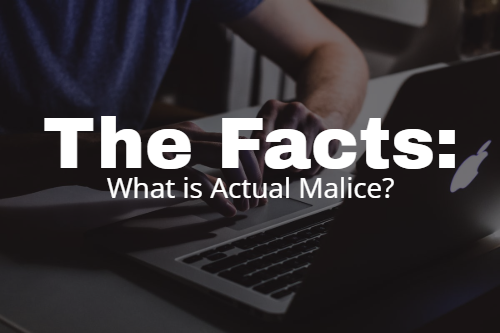
Actual malice refers to the legal requirement imposed on certain defamation plaintiffs when they file a lawsuit for libel or slander. Specifically, actual malice’s definition was laid out in the 1964 landmark defamation case of New York Times Co. v. Sullivan, which reads: “The constitutional guarantees require, we think, a Federal rule that prohibits a public official from recovering damages for a defamatory falsehood relating to his official conduct unless he proves that the statement was made with ‘actual malice’ – that is, with knowledge that it was false or with reckless disregard of whether it was false or not.” New York Times Co. v. Sullivan.
Simply put, if a public defamation plaintiff cannot prove actual malice, then they cannot recover damages. We’ll expand on this landmark case further in Section 2: The Significance of New York Times v. Sullivan.
At its very core, actual malice centers around two requirements (and may vary in some way by state), that the defamatory statement in question was either made with:
- Knowledge of the statement’s false nature, or
- Reckless disregard of the truth or falsity of the matter.
It’s important to understand that while the definition of actual malice alludes to public figures in the context of the media, it actually applies to all defendants, including individuals. Such standard is considered a necessary safeguard to prevent overly litigious persons/entities and frivolous lawsuits. Furthermore, public figures have availed themselves to certain levels of scrutiny, comment, and criticism in our society, and should therefore be discussed openly without fear of legal repercussion or censorship.
While the term actual malice was not actually created specifically for New York Times Co. v. Sullivan, it was given constitutional significance under Sullivan, and ultimately defined in a more thorough manner.
You might have heard the term ‘Common Law Malice’ thrown around occasionally, so let’s take a look to see how constitutional malice (also known as actual malice) compares to common law malice.
Constitutional Malice vs. Common Law Malice
Just above, we addressed the definition of constitutional malice, or what it’s more commonly referred to as – actual malice. Actual malice emphasizes two fundamental prongs: knowledge of statement’s falsity or reckless disregard for the truth of the matter asserted. Common law malice on the other hand specifically refers to a defamation defendant’s feelings towards the libel or slander plaintiff (much different from an express and explicit knowledge or disregard for the statement).
Common law malice emphasizes the concepts of ill will or spite, and will likely manifest itself under a different name in United States defamation law. We recommend first looking to the constitutional standard of malice to base your understanding off of, and then looking to your state’s specific requirements for actual malice – as this may affect your right to recover punitive damages. Keep in mind that while U.S. states may create a higher and stricter threshold for a libel plaintiff to prove in order to recover damages, they may not lower the threshold as required by the First Amendment.
We’ll address everything in depth below.
So, How Can You Prove Actual Malice?
That’s a great question, and luckily there are numerous ways a defamation plaintiff prove a defendant acted with actual malice or reckless disregard when publishing or communicating a statement.
As long as a defamation claim and lawsuit is supported by admissible evidence, then actual malice may be shown and proved. Malice may be proved via any competent and sufficient evidence – which may either be:
- Direct, or
- Circumstantial.
Just make sure evidence and circumstances being shown aren’t too remote, and it will likely be admissible. Such evidence and supporting circumstances which have generally been accepted are: past threats, other defamatory and false statements, subsequent statements by a defendant, evidence of ill will or hostility between both parties, and facts which prove a defendant’s reckless disregard.
Online Defamation Fact: When confronting defamation, it’s important to understand the form in which it’s conveyed, as it could significantly impact your legal rights and remedies under United States defamation law. Specifically, libel refers to a false written or published statement (including videos, photographs, and other media), while slander refers to a false spoken statement. When confronting online defamation, you are almost always dealing with libel. Note that most states have differing statutes of limitations for libel and slander claims, so remember to familiarize yourself with your state’s respective statutes.
History & Significance of New York Times v. Sullivan
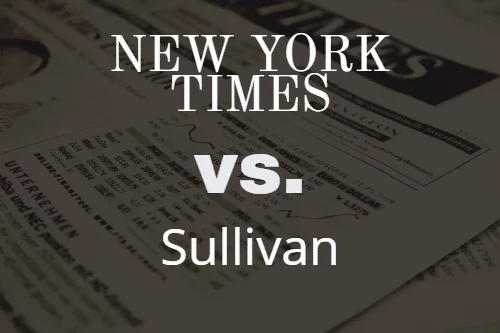
It should be no surprise by now that the most fundamental takeaway and overhaul brought forth by the Court in New York Times Co v. Sullivan was in the burden of proof established for public figures and persons when bringing a defamation claim. New York Times Co. v. Sullivan is one of the defining cases which supports and upholds “freedom of the press” in United States jurisprudence.
At the very heart of Sullivan was the defined distinction between both private and public defamation plaintiffs in the United States. Most notably, the Supreme Court ruled that it was imperative when determining libel plaintiff’s rights and remedies under U.S. defamation law, to impose two distinct burdens of proof – depending on what one’s status in the community is.
Prior to this ruling, there were roughly USD $300,000,000 accrued in libel lawsuits from Southern states (and still outstanding) against media outlets and news organizations – mostly due to the attempted suppression of coverage of the numerous civil rights issues and abuses taking place in those states.
You might be asking yourself, “why did the Supreme Court feel the need to draw a distinction between public and private plaintiffs?”
Simple. To further “uninhibited debate of public issues.” Differentiating between the two types of plaintiffs was absolutely essential for promoting free discussion and debate in today’s society, a fundamental requirement for a true democracy. Think about it, our democracy revolves around the right to free speech, and should we begin to start censoring persons who openly comment on influential members in society and the community, our democracy would soon fail and the general public would become less informed.
On top of that, the Court’s decision in Sullivan enabled newspapers and media outlets more freedom to accurately report on the overall chaos and abuses taking place during the Civil Rights Movement.
Finally, while the term “actual malice,” which was the burden of proof tacked onto defamation actions brought by public figures and persons, may at times protect inaccurate speech, it’s still incredibly important for the advancement of free debate. Justice William J. Brennan acknowledged that an “erroneous statement is inevitable in free debate, and … it must be protected if the freedoms of expression are to have the ‘breathing space’ that they need to survive.”
Defamation Law Fact: Keep in mind that when charged with a defamation claim, there’s numerous defenses a defamation defendant may rely on. Specifically, four of the most common defenses include: truth/falsity – while the truth hurts, it does not give rise to an actionable claim, opinion – if a statement may not be independently be verified as fact, then it will likely be considered opinion, privilege – certain statements are protected under free speech, and consent – think about it, if you consent to a publication, you can’t later rescind it and later sue for defamation.
Public vs. Private Figures: Actual Malice vs. Ordinary Negligence
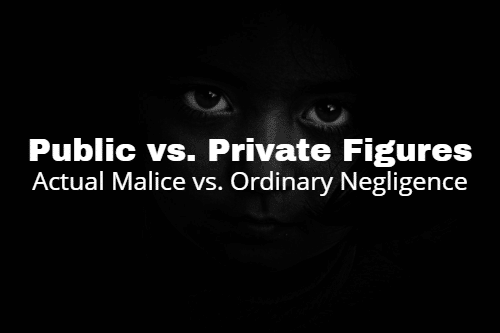
As we noted in the definition of actual malice, such legal requirement serves to prevent overly litigious persons and entities and frivolous legal claims from being filed in our already clogged judicial system. New York Times Co. v. Sullivan stresses that actual malice is the standard for public persons and figures, and must be proved in order for them to succeed in their claim.
So, why do public persons and figures have a stricter burden of proof to meet when bringing a defamation claim?
Public Figures/Persons & Actual Malice
In this section, we’re going to walk you through the two core types of defamation plaintiffs in today’s U.S. defamation legal-sphere, along with three subsets and categories.
For starters, actual malice as a burden of proof for public figures exists to further open discussion and debate – two concepts at the very heart of our democracy. Public figures and persons have taken upon a duty or status in society (voluntarily or involuntarily), which requires open comment, debate, and criticism. Without it (and should censorship run rampant), our very public would fail to stay informed, and our democracy would slowly erode. Imagine never being legally able to openly criticize a politician or celebrity.
As such figures have “voluntarily or involuntarily availed themselves” to the public light (or thrust themselves into the public light), they are required to prove a defamation defendant acted with actual malice when bringing a libel or slander claim.
Private Figures & Ordinary Negligence
Funnily enough, The Associated Press estimates that roughly 95% of all libel cases involving news stories are not high-profile, and considered “run of the mill” – meaning they likely concern local businesses, criminal investigations, and local trials. Cue private figures and citizens. If you’re reading this, there’s a high likelihood that you’re considered a private person or figure under United States defamation law. Specifically, private persons and figures are persons who have not voluntarily or involuntarily availed themselves to public comment, debate, or criticism, and as such, should be left alone.
Because private persons and figures do not “invite” public attention and comment, they are merely required to prove a defendant acted with ordinary negligence when communicating or publishing a defamatory statement. Ordinary negligence can be defined as acting outside the scope of how a reasonable person would act in similar circumstances. Should a private defamation plaintiff prove a libel or slander defendant acted with ordinary negligence, then they will be able to recover damages under U.S. and state defamation law.
Now that we’ve walked you through the two core types of defamation and libel plaintiffs in the U.S., let’s take a careful look at three different subsets of defamation plaintiffs:
- Public Official,
- All-Purpose Public Figure,
- Limited-Purpose Public Figure.
To compare all five types of defamation plaintiffs, we’ve constructed an educational table.
| Classifications of U.S. Defamation Plaintiffs | Private Persons/Plaintiffs | Public Officials | All-Purpose Public Figures (APPFs) | Limited-Purpose Public Figures (LPPFs) |
|---|---|---|---|---|
| Definition | All plaintiffs and persons who have not voluntarily or involuntarily availed themselves to public comment, criticism, or open debate. Private persons may also be defined as plaintiffs who do not fall within one of the three other categories. | Public officials are generally government employees, who occupy positions of potential social harm if abused or taken advantage of, or persons who have a substantial amount of control or responsibility over government affairs. | Sometimes referred to as ‘general-purpose public figures’, APPFs are typically persons who have attained notable status in society or the community, and assumed roles of special prominence (meaning they occupy a position of influence and power). | Plaintiffs who have generally voluntarily or involuntarily thrust themselves to the forefront of a particular event, issue, or controversy. Such persons then become an LPPF for a “limited” scope of issues. |
| Burden of Proof | Ordinary Negligence | Actual Malice | Actual Malice | *Actual Malice – however, actual malice generally only extends to the controversy for which the LPPF thrust themselves into the public light. |
U.S. Defamation Law Fact: Wondering whether you can sue out-of-state defendants for online defamation? Generally, most states have long-arm statutes which specifically lay out core criteria a plaintiff must meet and prove before suing an out-of-state defamation defendant. Such criteria typically includes whether a defendant purposefully availed themselves to the specific state, the effect of the defamation on residents of that state, and whether they possess any minimum contacts with the state where the defamation occurred.
United States and online defamation law is comprised of countless nuances and is constantly changing, therefore we recommend reaching out to an experienced online defamation attorney when confronting libelous online posters and trolls. Doing so will not only save you time, but hassle and future headache.
What are you waiting for? Reach out to the experienced and nationally recognized defamation lawyers of Minc Law now!
How Actual Malice Differs by State: Actual Malice Examples
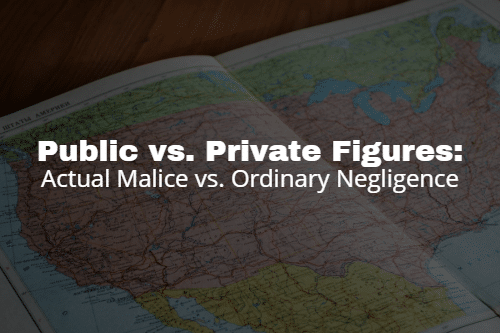
In this section, we’re going to take you through three (3) specific state examples of actual malice, showing you how various requirements and elements may differ by state in order for libel and slander plaintiffs to recover punitive damages.
First, before addressing the below state examples, let’s first understand what punitive damages are.
Punitive damages – also referred to as ‘exemplary damages’ – are damages sought by the plaintiff which are meant to punish a defendant who acted in an especially malicious or wanton manner. They are generally enforced in cases of violence, fraud, and other inappropriate instances of conduct.
In the context of U.S. defamation law, punitive damages are awarded in cases where a defendant published or communicated a defamatory statement in an especially egregious or malicious manner. Let’s take a look at 3 state examples to see their respective requirements for the procurement and enforcement of punitive damages.
Defamation Law Fact: The United States is typically considered very pro-defendant when it comes to defamation claims and laws, due to its longstanding enforcement of free speech and the U.S. Constitution. European countries and other Commonwealth countries (ex. Australia, United Kingdom, and Canada) are generally considered more pro-plaintiff friendly.
New York Actual Malice & Punitive Damages
Under New York defamation law, actual malice involves a defendant’s subjective statement of mind at the time or point a defamatory statement was communicated or published. Furthermore, New York courts will look to whether the speaker or published actually believed the statement was false, or published it with reckless disregard – this also includes a high probability of awareness that the statement was not in fact true.
To recover punitive damages under New York defamation law, a libel or slander plaintiff must not only prove actual malice, but show common law malice as well.
Remember, common law malice is comprised of spite or ill will by the defendant.
California Actual Malice & Punitive Damages
In order for libel and slander plaintiffs in California to recover punitive damages, they must prove both:
- Actual malice or reckless disregard, and
- Common law malice – ill will, spite, and a heightened degree of awareness of falsity.
Broken down even more, this means that California libel and slander plaintiffs must show:
- Conscious & Willful Disregard: A plaintiff will have to prove that the defendant published or communicated the defamatory statement in question with a conscious and willful disregard of another’s rights, in a manner “so vile, contemptible, miserable, wretched or loathsome that it would be looked down upon and despised by ordinary decent people.”
- Ill Will & Hatred: It must be shown that the defendant in question made a defamatory statement with a “state of mind arising from hatred or ill will toward the plaintiff…”
Note that if a California defendant was “occasioned” by a good faith belief that part or all of the statement was true, then a court will not find actual malice.
Ohio Actual Malice & Punitive Damages
Ohio, like the above two states, requires defamation plaintiffs to prove “actual malice” and common law malice in order to recover punitive damages. Specifically, Ohio law requires the proof of:
- The defendant having made the libelous or slanderous communication/statement “with knowledge that [the statement] was false or with reckless disregard of whether [the statement] was false or not.”
- The defendant having made the defamatory communication or statement with hatred, ill will, a spirit of revenge, or conscious disregard for the safety and rights of other parties.
There are however exceptions to Ohio’s stance on the enforcement of punitive damages. In on case, Gilbert v. WNIR 100 FM, an Ohio court did not rule out the possibility of enforcing punitive damages in cases where a defendant’s fault never rose to the level of malice. They noted: “[I]f the plaintiff is a private individual and the matter is not of public concern, the plaintiff need not show actual malice to recover punitive damages.”
The case is significant due to its discussion of non-malice-based punitive damages recovery – leaving the door open for potential legal cases in the future.
To dive into each state’s respective libel and slander laws, we recommend you head on over to our Legal Resource Center and check out our mega-page tackling U.S. Defamation & Libel Laws. It includes an interactive defamation map, and everything you need to know about today’s defamation framework in the U.S.
Trump Libel Laws & Actual Malice
While it’s obvious U.S. states often differ in their definitions of libel, slander, and defamation, there’s a chance that U.S. defamation law could begin to take a far different shape than what it is. In 2017, after two Watergate reporters appealed for a closer examination of Donald Trump’s ties to Russia (post-election), Trump’s chief of staff made several statements implying today’s libel laws as we know it might be subject to repeal or change in the coming years.
Mix in added frustration from the president after author and essayist Michael Wolff’s published his book Fire and Fury: Inside the Trump White House – which detailed an unflattering look into the White House and Trump himself. Trump described present day libel laws affecting our free media as a “sham and a disgrace,” noting such reportings were not news at all.
Such statements fail to acknowledge the longstanding history by which our present day libel and media laws have developed, as the Court in New York Times heavily weighed the general public’s right to free speech and open debate, with the rights of public figures. This ruling has stood the test of time, as it has been carefully and thoroughly constructed. It’s worth noting that just because a public figure or party feels aggrieved or insulted by the media and general public, this does not provide legitimate grounds for complete overhaul of a tried and tested principle/system.
Justice William J. Brennan, who ultimately issued the Sullivan decision opined: “Although the Sedition Act was never tested in this Court, the attack upon its validity has carried the day in the court of history.” Furthermore, as libel is a matter individually addressed by all 50 states, there is no federal libel law to be altered or amended. Such change would likely only come through the overhaul and destruction of the First Amendment.
Summing up the matter succinctly, Arizona Republican Senator Jeff Flake stated, “It was the year in which an unrelenting daily assault on the constitutionally protected free press was launched by that same White House, an assault that is as unprecedented as it is unwarranted.”
Take solace in knowing that our current libel and defamation laws are likely not being repealed or overhauled in any significant way in the near future.
Libel Removal Fact: When approaching online libel and defamation, we strongly recommend you document everything. While the Internet has a way of preserving information, it also has an uncanny way of altering it. Screenshotting the offensive and libelous material in question is an effective way to combat online defamation and help refute any claims of evidence tampering. Furthermore, we also recommend having a trusted family member or friend make a second copy of the material.

Work With the Online Defamation Attorneys of Minc Law Today!
Have you been the victim of online defamation, libelous posts and comments, or malicious accusations? Contact the internet defamation lawyers of Minc Law now! At Minc Law, we’re here to fight for your reputation, and have proven success in the online defamation removal arena.
Specifically, in our tenure as nationally recognized and experienced online defamation lawyers, we’ve removed over 25,000 websites and pieces of content from the Internet, litigated in over 22 states and 3 countries, and boast a nearly 100% online defamation takedown rate. That’s not all! We also do it all for a flat, reasonable fee. What are you waiting for? Reach out now!
Here’s what you can expect when working with the Ohio-based defamation attorneys of Minc Law:
- Courtesy & Respect: At Minc Law, we understand how overwhelming and stressful online defamation and false posts can be. Just know that we’re always on your side, and here to make the removal process as painless as possible. After all, your goals are our goals!
- Open Dialogue & Communication: Unfortunately some attorneys go missing or silent once the online defamation takedown process has begun, not us. We know how important it is to stay informed about your case, so rest assured we’ll be keeping you in the loop!
- Proven Results: Websites and businesses respond to Minc Law! As mentioned above, we’ve removed over 25,000 pieces of libelous and false content from the web, and know who to work with. Having worked tirelessly with countless website administrators, content managers, and third-party arbitration firms, we know what it takes to secure swift and permanent results!
Don’t hesitate! Reach out to us today to schedule your free, initial no-obligation defamation consultation with an intake specialist by calling us at (216) 373-7706, or scheduling a meeting by filling out our online contact form!
It’s time to take back your online reputation!
★★★★★
They were very understanding. They did not judge me and they were very helpful. It gave me peace of mind to have someone who I could turn too in a stressful situation.
Jordan, January 7, 2022

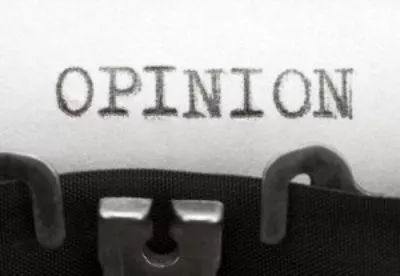
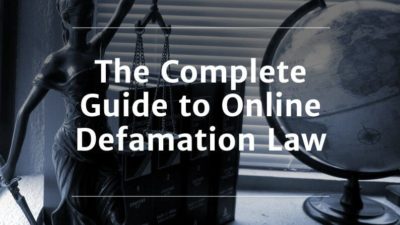
![The Importance of Online Reviews: 50+ Key Statistics to Know [2020] featured image](https://www.minclaw.com/wp-content/uploads/2020/08/online-review-statistics-2020-400x0-c-default.jpg)